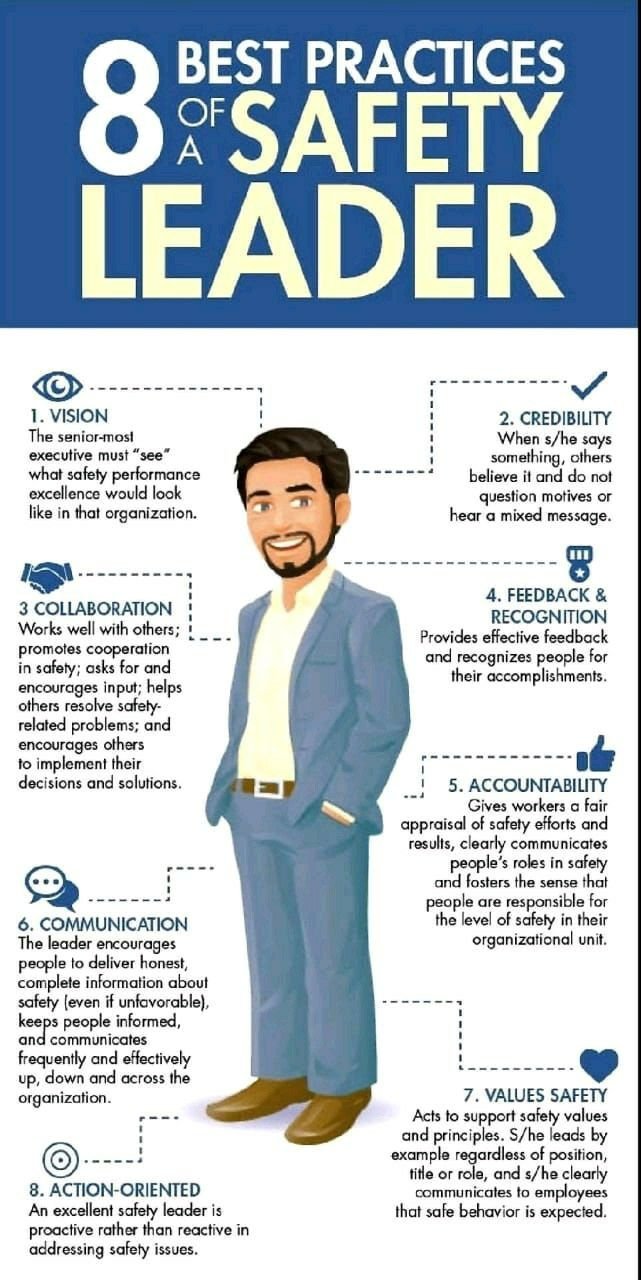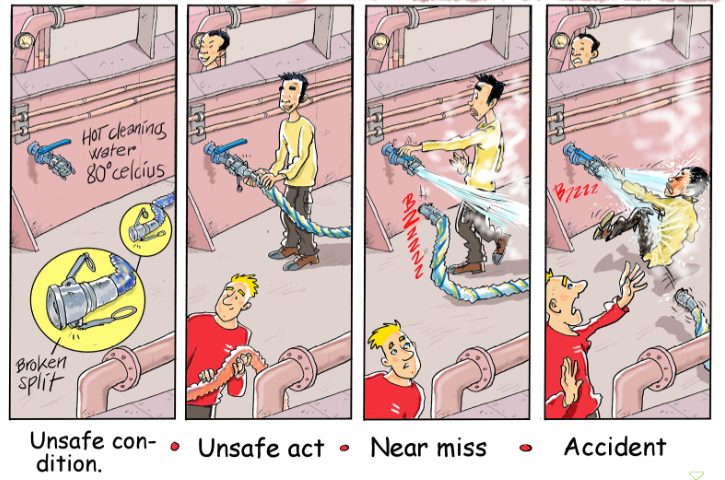An organization needs leadership to drive great performance in all areas.
Leaders are critically necessary to help define safety goals, develop implementation procedures, and ensure compliance for the company’s safety programs. Most importantly, a safety leader must consistently motivate other employees to effectively mitigate safety risks. In this edition of the safety blog, we’ll explore the difference between managing safety versus being a safety leader.

Safety Leaders Versus Managers
Safety leaders are the team leads that others rely upon, to consistently meet the safety goals of the organization.
Managers are part of the organization’s hierarchy and have defined responsibilities for their segment of the business to include the standard supervisor role with respect to subordinates.
Leadership means “to influence followers” – and this does not necessarily mean the department manager. A leader is able to influence the activity of the team in a way that ensures safety goals are met as a team. A manager can certainly be a leader for safety, but the primary distinction is leaders influence the team to voluntarily recognize and fulfill their role in the company’s safety program.
The OSHA Safety Model

The Occupational Safety and Health Administration (OSHA) has a defined model that outlines the key objectives for safety leadership, regardless of the leader’s role in the company. The OSHA STARS model describes the requirements for safety leadership:
Supervision: overseeing work activities to make sure employees are safe
Training: conducting safety education and training
Accountability: insisting that everyone complies with company safety policies and rules
Resources: providing physical resources – tools, equipment, materials – so employees can work safely
Support: creating a supportive psycho-social work environment – schedules, workloads, recognition – so employees do not work under undue stress
The model starts with supervision to ensure employees are safe, but this does not necessarily mean direct supervision by management.
A key function of safety leaders is to ensure safety procedures are followed on the job and workers are safe. A review of the remaining components of the model provides the necessary requirements of a safety leader.
These are important attributes of safety leadership and do not always require performance by a member of the management team. A leader that emerges from the team of workers from the shop floor, or job site, provides a valuable connection to the operational team.
This connection can provide the daily influence to maintain safety procedures and avoid accidents.
Leadership Characteristics

As stated above, leadership does not always mean a manager or supervisor. It does require individuals with the leadership ability to influence the rest of the team in meeting the goals of the safety program.
A key characteristic of safety leadership is a real commitment to helping people stay safe. This genuine concern, along with the ability to inspire others to follow safety steps, is vastly different than management commands to follow the rules.
This is an important distinction and one that more often leads to consistent safety results at the job site.
In Summary
Regardless of the specific role in the company, a leader is able to influence the activity of the team. A manager can certainly be a leader for safety, but the primary distinction is leaders influence the team to voluntarily fulfill the required safety procedures. The voluntary aspect is an important distinction that leads to consistent safety results.
Contact us today to find out more about our services at Advanced Consulting & Training. We are a safety training leader in Ontario, helping organizations large and small become safety leaders themselves.
Download the photo
More photos:
- Photo of the day: Identify the Hazards
- Photo of the day: Hand safety Facts
- Photo of the day: What are the hazards
- Photo of the day: Outline Safety observations
- Photo of the day: Safety Leader
- Photo of the day: Unsafe Conditions
- Photo of the day: Why is PPE important?
- Photo of the day: DO’S and DON’TS of Working At Heights
- Photo of the day: 5 Tips to keep your Crew Healthy and safe at work
- Photo of the day: Tracking Near Miss Incidents
- Photo of the day: 10 Elements of Successful Behavior-Based Safety Program
- Photo of the day:5-Signs your Near-Miss Reporting is failing
- Photo of the day:7 Ineffective Safety Practices (And What To Do Instead)
- Photo of the day:5 keys for effective Self-Management in lone worker safety
- Photo of the day: FrontLine supervisors are the LINCHPINS of safety
- Photo of the day: Fostering Engagement at the front line
- Photo of the day: workplace Hazards
- Photo of the day: What is the line of fire
- Photo of the day: How to Avoid the Fatal Four
- Photo of the day: Fire Safety checklist for workplace
- Photo of the day: Most common safety incidents in the workplace
- Photo of the day: Fire Emergency
- Photo of the day: Ladder Safety Tips
- Photo of the day: 8 Basic steps to wear a safety harness
- Photo of the day: You can prevent workplace Falls
- Photo of the day: Top10 Injuries in office work
- Photo of the day: Overhead powerline safety
- Photo of the day: Eyes on the Road The challenges of safe driving
- Photo of the day: 5 Ways to Reinforce Commuting With Positive Reinforcement
- Photo of the day: Safe Lifting at work
- Photo of the day: 5 Essential outcomes of an effective leadership survey process
- Photo of the day: Conveyors Safety Tips
- Photo of the day: Confined Space rescue
- Photo of the day: Construction Site fire Safety
- Photo of the day: Chemical Spill Emergency Response
- Photo of the day: Electric shock survival
- Breath Safely: The Proper Use of Respiratory Protection
- Photo of the day: Confined space safety Precautions
- Photo of the day: Choosing the Right Face Mask and the difference between a respirator and face mask
- Photo of the day: Importance of Mock drill and Fire Action Emergency Procedure
- H2S Gas and how to handle its Emergency
- Your steps to chemical safety
- Photo of the day: hierarchy of controls
- Photo of the day: Tips to reduce Heat stress in the workplace
- Photo of the day: Safety Equipment for Confined Spaces
- Photo of the day: Dangerous Goods Classes
- Photo of the day: Trenching Safety Tips That Can Save a Life
- Photo of the day: Mental health in the workplace
- Photo of the day: Emergency preparedness in the workplace
- Photo of the day: musculoskeletal disorders
- Photo of the day: Workplace Inspection
- Photo of the day: New worker Orientation & Safety Orientation checklist
- Photo of the day: Effective Health and Safety Committees
- Photo of the day: 10 Scaffold Safety Essentials
- Photo of the day: Incident Investigations
- Photo of the day: Preventing the spread of contagious illness
- Photo of the day: 5 ways to reduce the risk of Slipping and Tripping
- Photo of the day: Sitting at work
- How to use Plate Clamps Safely: Safety Moment#34
- Photo of the day: working in heat and Humidex Rating
- Photo of the day: Don’t be Driven to Distraction
- Photo of the day: Fatigue at Work
- Photo of the day: Noise in the affected workplace
- Photo of the day: Indoor Air Quality
- Photo of the day: WHMIS 2015 – Pictograms
- Photo of the day: Personal Protective Equipment last resort
- Photo of the day: Manual Material handling
- Photo of the day: Controlling COVID-19 in the Workplace-Physical Barriers
- Photo of the day: Generator Safety
- Photo of the day: Position for safety and comfort-Safety Tips
- Photo of the day: Cannabis and Impairment in the Workplace
- Photo of the day: sun safety in the workplace
- Photo of the day: Top FIVE Heavy Equipment Construction Site Safety Tips
- Photo of the day: Work-Related Asthma
- Photo of the day: choosing the right Anchorage
- Photo of the day: Protect your Head
- Photo of the day: Extension Cord Safety Tips
- Photo of the day: Concrete Truck Driver Hand Signals
- Photo of the day: Safe use of ladders and step ladders
- Photo of the day: Arc-Fault Circuit Interrupters (AFCI)
- Photo of the day: HSE Bulletin Board
- Photo of the day: Scissor Lift Safety
- Photo of the day: Managing Risks of Exposure to Solvents in the workplace
- Photo of the day: Flagman and Traffic control
- Photo of the day: Run Project safely with Crane Hand Signals
- Photo of the day: Read All Labels Work safe
- Photo of the day: Flood Safety Tips
- Photo of the day: Fall Protection Plans
- Photo of the day: Lockout and Tagout Safety
- Photo of the day: Types of Hand Protection
- Photo of the day: Types of Foot Protection
- Photo of the day: Floor Marking
- Photo of the day: Overhead Power lines Clearance





nice
very useful thank you for sharing